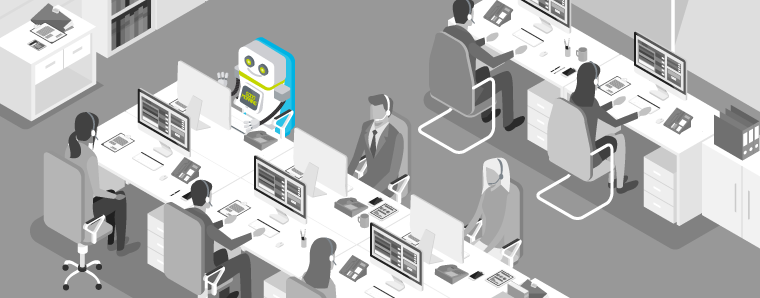It’s the AI revolution . . . and it’s not that bad.
Call center automation is opening the door to better interactions between businesses and customers. But there’s a fear that as automation becomes more widespread and intelligent, it may take over completely. Not in a Skynet-y, iRobot way—more like a “replacing human workers” kind of way.
And those fears aren’t entirely unfounded. For example, there’s the McDonald’s “kiosk craze.” The fast food giant is replacing cashiers with self-service kiosks. McDonald’s anticipates adding kiosks to 2,500 restaurants by the end of this year, and another 3,000 the next. There’s also plans in the works to roll out mobile ordering some time in the future.
As robots take over many industries, the numbers become pretty sobering.
- Each robot replaces an average of 5.6 workers.
- One robot on the job reduces the wages of 1,000 workers between a quarter and one-half percent.
- Economists predicts that by 2025, a potential 3.4 million jobs will be lost to robots.
Widespread acceptance of AI instead of panic.
Despite these statistics, consumers don’t seem all that concerned about AIs taking over, and neither are businesses. Gartner lists AI as the leading technology trend for this year, and predicts that by 2020, 85 percent of all customer interactions will be managed by machines—not humans. That doesn’t really seem to signal a lot of fear on our part for what is basically the rise of ruthless, relentless, and soulless thinking machines.
We can probably chalk a lot of this acceptance up to a growing preference among consumers for self-service, especially among Millennials. They avoid unnecessary interactions unless absolutely necessary. AI technology opens up opportunities to explore products, services, and support without unwanted contact with aggressive salespeople.
Another factor is consumer demand for virtual assistants like Alexa, Siri, and Google’s Home Assistant. This year alone, the number of virtual assistants in the U.S. is predicted to grow by 23.1 percent. This has helped bring AIs into the the home and practically made them a member of the family. This development has also conditioned customers to rely on virtual assistants for quick information, shopping, and coordinating between other smart devices.
So have the machines won? Not by a long shot—at least, not in call centers.
Why call centers still need people.
Automation hasn’t fully taken over call centers, but they have taken hold in a big way. Intelligent call routing, queuing, and data acquisition has improved call center performance and created greater convenience for both customers and workers. But will they ever completely take over? That’s where there’s some doubt. Here’s why:
- Sometimes you need to talk to a person. We’ve all been in those fixes where a set of menu options won’t solve our problem. We need to talk to a real person and nothing else will do. In fact, 63 percent of people over the age of 35 prefer to talk to a human, and 67 percent of callers hang up in frustration when they have to deal with automated systems.
- AIs can be too literal—and impersonal to boot. Despite their awesome computing power, AIs are still too literal to really understand all your requests. How many of you are sick of hearing, “Sorry, I don’t understand,” from your virtual assistant? They respond that way because AIs’ capability to grasp non-literal or complex concepts still has a long way to go. And who likes being stuck looping through endless menu options on a help line, listening to robotic responses that don’t address your problem? At that point, all you usually want to do is get through to a person.
- Automation costs money. Automation software is still in its development stages, so the latest in artificial intelligence software is going to cost you.
- Greater potential for error. Just like in the movies, the smarter and more complex your AI, the greater the likelihood it’ll short circuit. Whether it’s bad code or bad data, the potential an AI could go off-reservation is very real. Just look at Microsoft’s chatbot, Tay, which was programmed to talk like a teenage girl. Less than 24 hours of exposure to Twitter had Tay spewing racist and sexist slurs mixed with conspiracy theories. Naturally, Microsoft pulled the plug and took Tay back to the drawing board. An AI call center could just as easily short-circuit an interaction with a customer if it isn’t monitored for customer satisfaction.
The real role of AI in call center automation.
AIs won’t be taking over call centers anytime soon. For now, their primary function, even in the most advanced call center, is to aid and augment call center agents. Instead of replacing human workers, AIs simply provide greater access to data and tools that lead to positive interactions with customers. Here are three ways they do it:
#1. Chatbots
AIs called chatbots (or AI-bots, smartbots, or simply bots) have taken over the function of interactive voice response (IVR), providing customers with real-time responses to basic questions. Customers can resolve their issues with minimal effort and human interaction, and call centers can reserve their agents for more complex issues. The scary thing is that chatbots are becoming so advanced that, after an interaction with a call center, 27 percent of customers weren’t sure whether they spoke with a person or a chatbot. Spooky.
#2. Omnichannel experiences
Although the phone is still considered the primary tool of the call center, current trends point to a future where the phone is just one of many channels a customer can choose. Customers who are uncomfortable interacting over the phone can pick a preferred channel, including chat, video, email, instant message, or social media. And if a customer swaps channels in the middle of an interaction, a call center can use AIs to better track them across those different channels.
#3. CRM integration
When a customer requires attention from a call center agent, AIs can also enhance those interactions. Integrations between the call center’s customer relationship management (CRM) software and phone system can automatically pull up that customer’s records and previous interactions. This gives the agent critical information and context before he or she even answers the phone.
Humans still reign in the call center.
We can put away our pitchforks and torches for now. No AI-Frankenstein’s monster is going to be taking over the call center. At least not yet. Not while customers and call centers alike still value emotional intelligence and human interaction for critical issues. But with the mainstream acceptance of AIs, watch out for future advances in call center automation.

